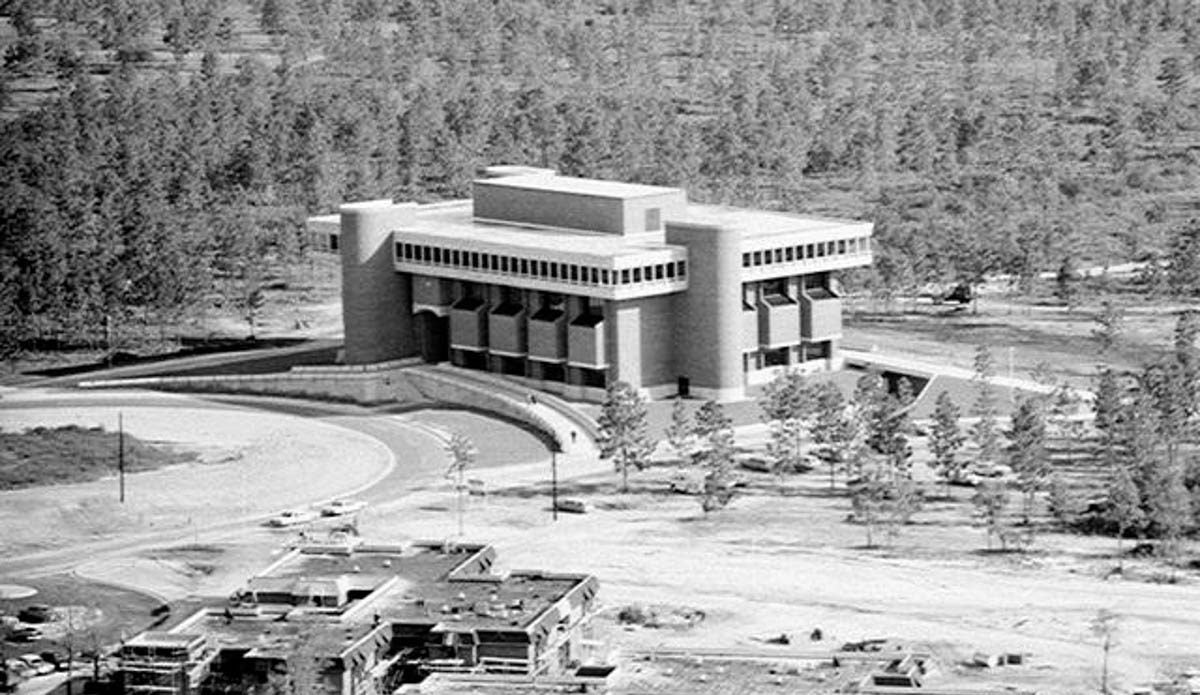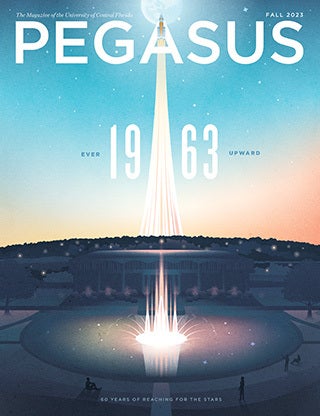One building on the UCF campus has quite the storied background — about 1.3 million stories, in fact.
That’s how many books are on the shelves of the main campus library, which was dedicated 50 years ago on Oct. 7, 1968, as the first building constructed among acres of pine trees.
The First Chapter
When the building opened, it served many functions that were central to the life of the administration, faculty, staff, students, clubs and other organizations on the blossoming campus.
“In 1968, the university library building housed a dream, an exciting new idea: that a great university would grow in Central Florida,” says Meg Scharf, associate director for communication, assessment and public relations for UCF Libraries. The library still has the shovel that turned the first spade of earth at the university’s groundbreaking on March 19, 1967.
In 1968, the university library building housed a dream, an exciting new idea: that a great university would grow in Central Florida.
In addition to a small collection of books at the opening — 2,500 ready for checkout and another 34,000 being processed for circulation — the bustling five-story building housed offices, classrooms and, in the basement, the campus bookstore. On the first day the library opened, one of the books checked out by President Charles N. Millican was the Bible.
Soon the diverse building also became the home to a multitude of other organizations and purposes, such as: The FuTUre student newspaper and campus radio station, periodicals and government documents, the wrestling team’s competitions in the basement, art shows and other activities. There’s even a taxidermied Vincent the Vulture, from when the vulture was an early contender as the university mascot.
As more buildings were completed on campus, this allowed offices and organizations to relocate so that more space was opened up to expand the library’s collections and departments.
The original 118,000-square-foot structure grew to 226,000 square feet during an attached four-story expansion that was finished in 1984.
In 2012, the Florida Board of Governors approved UCF’s Board of Trustees vote to name the library the John C. Hitt Library in honor of his 20th anniversary as president of the university.
Through the years, UCF Libraries has expanded beyond the footprint next to the Reflecting Pond in the center of campus. The system also includes the 5,500-square-foot Curriculum Materials Center in the Education Complex, the 9,500-square-foot Universal Orlando Foundation Library at Rosen College of Hospitality Management, and partner libraries with state colleges throughout Central Florida.
Skipping Ahead to the Future
As the library holds onto the past — it owns a 14th-century Gregorian chant manuscript and a 1546 printed Bible — it also looks to the future as it currently undergoes its second major expansion, another four floors that will bring the total library space to 250,000 square feet and include an automated retrieval center on the north side of the library.
The ARC building will have a capacity of 1.25 million volumes of the library’s print collection, placed in bins stacked three stories high for retrieval by five robotic cranes. Patrons will be able to request books with the click of a button on a computer screen and each volume will be available for pickup at the circulation desk. About 250,000 volumes will remain on open stacks for browsing.
Many libraries around the world, including more than 20 in the United States, have installed retrieval centers, including the University of Chicago, North Carolina State University and Georgia Southern University. This is the first in Florida.
“A 21st-century library is now being created to continue to match the university’s boundless growth and research aspirations, supporting the contributions of students and faculty to the intellectual and cultural life of Central Florida and beyond,” Scharf says.
The first phase of the ARC will be completed this fall. Transferring books into the shelves will free up space for up to 1,300 additional user seats in the library. When the renovation is complete, there will be 3,264 varied types of seating for individual and group study.
In the next phase of the project, a building connecting the ARC to the existing library building will be completed, and the fourth floor will house a reading room surrounded by windows overlooking the plaza in front of the Student Union.
With so many computers, cellphones and other electronic devices in use these days, scores of electrical outlets are being installed to allow charging. Most seating will be within arm’s length of an outlet.
The library has become a part of the UCF experience for every student and faculty member.
The library’s main entrance also will be moved from the south of the building near the Reflecting Pond to the north side facing the Student Union. The existing entrance facing the Reflecting Pond will remain open.
“The library has become a part of the UCF experience for every student and faculty member, regardless of the area of study or academic program,” Scharf says. “Traditionally, students and faculty would begin research and study using print indexes, the card catalog and the assistance of librarians.
“Fast forward to the 21st century. From a repository, with services designed around the use of the collections, the John C. Hitt Library and the UCF Libraries have evolved into exciting creative learning spaces, and places where new knowledge is created. Library services and space are now designed around the needs of students and faculty. Quiet space for solitary scholars still exists but it is now augmented with technology.”
There are also about 144,000 e-books in the library’s collection and another 231,000 materials in the system’s other libraries. Attendance at the library totaled 1.3 million visits during the 2016-17 school year.
That has also resulted in about 18,300 interactions by patrons at the Research and Information Desk, and another 8,230 “Ask Us” virtual-reference interactions during that same timeframe.
Even with all the changes through the decades, the library has kept its focus on students and faculty.
“The 21st-century library has its roots firmly in the tradition of 1968,” Scharf says. “Print collections continue in importance, but technology adds immediate access to a startling number of library and other resources. To support research and teaching, the John C. Hitt Library building will continue to evolve to accommodate these exciting, dynamic changes.”





